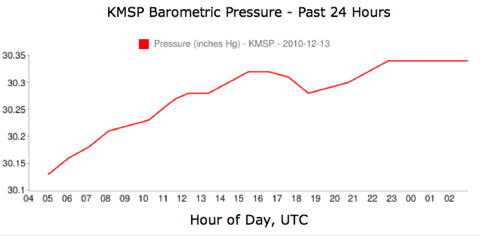The Metrodome collapse and internal pressure
December 12, 2010 at 10:39 PM by Dr. Drang
You’ve probably already seen this video, but here it is again.
That’s the Metrodome in Minneapolis, home of the Minnesota Vikings and former home of the Minnesota Twins and the University of Minnesota Golden Gophers football team. The roof is—or was, before the collapse—an air-supported structure. It’s made of fabric with a set of criss-crossed cables and is held up by keeping the air pressure in the building higher than the air pressure outside.
Under normal circumstances, the cables give the roof its shape and tie the fabric down to the rim of the stadium. Since the collapse, the cables have been keeping the fabric from falling down onto the playing field.
How much internal pressure is necessary to keep the roof aloft? That depends on the weight of the roof materials (what structural engineers call the dead load), the weight of the snow on the roof, and any additional external pressure on the roof due to winds.1 Let’s take the easy way out and ignore the pressure from the wind—even though I suspect that was significant in bringing down the roof—and just look at the dead load and the snow load.
According to this Metrodome information page, the fabric roof weighs about 310 tons. Scaling off Google’s aerial view of the stadium, I estimate the roof is about 600 feet wide and 750 feet long, which corresponds well with the “10 acres of teflon-coated fiberglass” mentioned on the info page. So the dead load, in pounds per square foot (psf) is:
Let’s bump this up to 2 psf account for the cables and all the lights and other things hanging from the roof. This is still incredibly light. I’m used to dealing with roofs that weigh 5 psf or more.
Minneapolis is said to have had about 17 inches of snow before the collapse. Ignoring both melting and localized buildups—both of which, like the wind pressure, would have to be considered if we were doing a real analysis—this is equivalent to about 2 inches of water. I’m using this chart from NOAA to do the conversion; it says that snowfall near 32° generates about 10% of its depth in meltwater.2 The unit weight of water is 62.4 pounds per cubic foot (pcf), so a 2 inch depth of water exerts a pressure of
Adding the dead load and the snow load, let’s say we have about 12 psf to support. Since we don’t usually express atmospheric pressure in pounds per square foot, we’ll have to convert this to more common units to get a sense of pressure difference inside the Metrodome.
Weather reports in the US usually express atmospheric pressure in inches of mercury, a unit that comes from the old mercury barometer. Mercury has a unit weight of 845 pcf, so 12 psf is the pressure associated with
This is the pressure differential between the inside and the outside of the Metrodome necessary to keep the roof up with 17 inches of snow on it. It’s pretty small. In fact, it’s less than today’s barometric pressure variation in Minneapolis:

Even though this pressure differential is small, the Metrodome’s volume is so great it takes several huge fans blowing air into the dome to maintain it. Since I haven’t heard of any problems with the fans, I would guess that today’s collapse was due to high concentrations of snow on certain portions of the roof, combined with pressure from the wind, leading to local tearing of the fabric. Once the fabric tears were large enough, the internal pressure difference couldn’t be maintained and the roof bowed down. That led to even greater concentrations of snow in the valleys, and the huge tears that eventually developed.
-
Wind pressure is a tricky thing and is highly variable over the roof, even when the wind speed itself is relatively steady. Generally speaking, the pressure will be positive—pushing in on the roof—on the windward side and negative—lifting the roof—on the leeward side. ↩
-
You may have heard that the water equivalent of snow can be 20% or more of the snow depth. Water equivalents this high are usually meant to be used for snowpack that’s been on the ground long enough to compress into a denser form, not for newly-fallen snow. ↩
